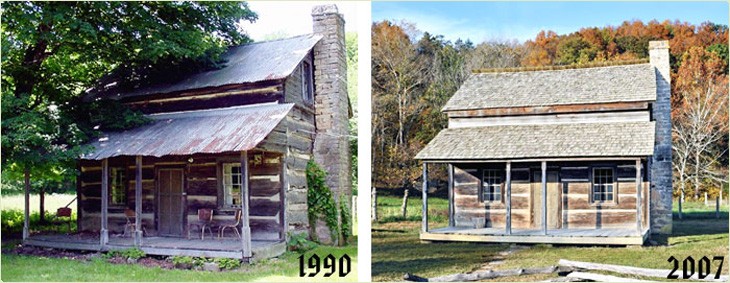Buford–Carty Farmstead and Museum
Introduction
Text-to-speech Audio
Built by enslaved African Americans during the early 1840s, the Buford-Carty Farmstead was continuously owned and operated by the Buford, Carty, and Goggin families. The home is one of the few remaining from the era which corresponds with the arrival of some of the first Americans of European and African descent in the area. In the 1830s, a small number of families established a settlement and church on the Middle Fork of the Black River, and this well-preserved log cabin represents the earliest permanent settlement of Missouri's rugged interior and Ozark regions during that time period.
Images
Buford-Carty Log Cabin

1990 vs 2007 image of the Buford-Carty Log Cabin from their official website. Restorations occurred in 2006.

Backstory and Context
Text-to-speech Audio
Built by enslaved African Americans in 1847, the Buford-Carty Farmstead was continuously owned and operated by the Buford, Carry, and Goggin families, who represent some of the first European American families to establish a settlement and church on the Middle Fork of the Black River in the early 1830s. The log cabin represents the earliest permanent settlement of Missouri's rugged interior and Ozark regions.
Located in the foothills of the Ozarks, or the Ozark Highlands, Reynolds County derives its name from Missouri's seventh governor, Thomas Reynolds. The influx of French, Spanish, and eventually United States citizens displaced Native Americans, who had called the area their home for centuries. During the 1830s, a considerable migration of families from Cumberland County, Kentucky, arrived in the Three Forks area and consequently became the first Euro-American families to establish permanent farming communities in the region. This migration included the Carty and Goggin families. The Buford family, who had first settled east of the Three Forks area in Bellevue, later joined the Carty and Goggin families. The Bufords and Cartys actively participated in local government after the creation of Reynolds County in 1845.
The Buford, Carty, Goggins, and many other families emigrated to Missouri from southern states and territories, bringing a slave-owning culture to the Ozark Highlands. Indeed, during the Civil War, members of the Buford, Carty, and Goggins families served in the Confederate Army. So, while several natural and human-made features are named for the "founding families," the log cabin serves as a reminder of the significant contribution made by enslaved African Americans in developing the area.
The Buford-Carty Farmstead was among the earliest established farm sites in Reynolds County. In fact, the farm initially existed as part of Washington County until population growth warranted the formation of Reynolds County. Two years later, the Buford-Carty log house arose. The log building represents a period of history in which people routinely lived in log homes as they progressed westward in the expanding United States. Still, while stories of the American frontier and log cabins are ubiquitous, few note that slaves often helped develop towns and build structures. Enslaved African Americans built the historic log house; The log cabin's survival into the twenty-first century speaks to the skill provided by its builders. One can find an inscription under the comer staircase of the first-floor room that reads, "Slaves of G. B. Goggin."
A 1920s barn on the historic property, along with the family cemetery, points to the evolution of the isolated family farm during the early twentieth century. Log cabins gave way to farmhouses, barns, and silos as family farmers grew diversified crops and raised various types of animals. Families then passed on their farms from generation to generation.
An architectural note:
"When we restored the log house 2004-2006, the steel roof was replaced with a wood shake shingle roof, making it as close to the original construction as possible," Kevin C. Skibiski, Trustee, Carty Branch Family Trust
An interesting tidbit:
Pamela Goggin was the grandmother of Samuel Clemens, better known as the famous American satirist Mark Twain. The Mark Twain National Forest surrounds a portion of the Buford-Carty Farmstead.
Sources
"Buford-Carty Cabin." Reynolds County Museum. rcghs.org. Accessed June 24, 2022. http://www.rcghs.org/buford-carty-cabin/.
Buford, Marcus Bainbridge, George Washington Buford and Mildred Buford Minter. "History and genealogy of the Buford family in America with records of a number of allied families." Archive.org. 1924, 1903. https://archive.org/stream/historygenealogy00bufo/historygenealogy00bufo_djvu.txt.
Community and Conflict: The Impact of the Civil War in the Ozarks. Accessed June 24, 2022. https://ozarkscivilwar.org/.
Gould, Joan L. "Registration Form: Buford-Carty Farmstead." National Register of Historic Places. 2003. https://mostateparks.com/sites/mostateparks/files/Buford-Carty%20Farmstead.pdf.
Ozarks Afro-American Heritage Museum Online. Accessed June 24, 2022. https://oaahm.omeka.net/.
http://landmarkhunter.com/119397-buford-carty-log-house/
http://www.rcghs.org/buford-carty-cabin/
